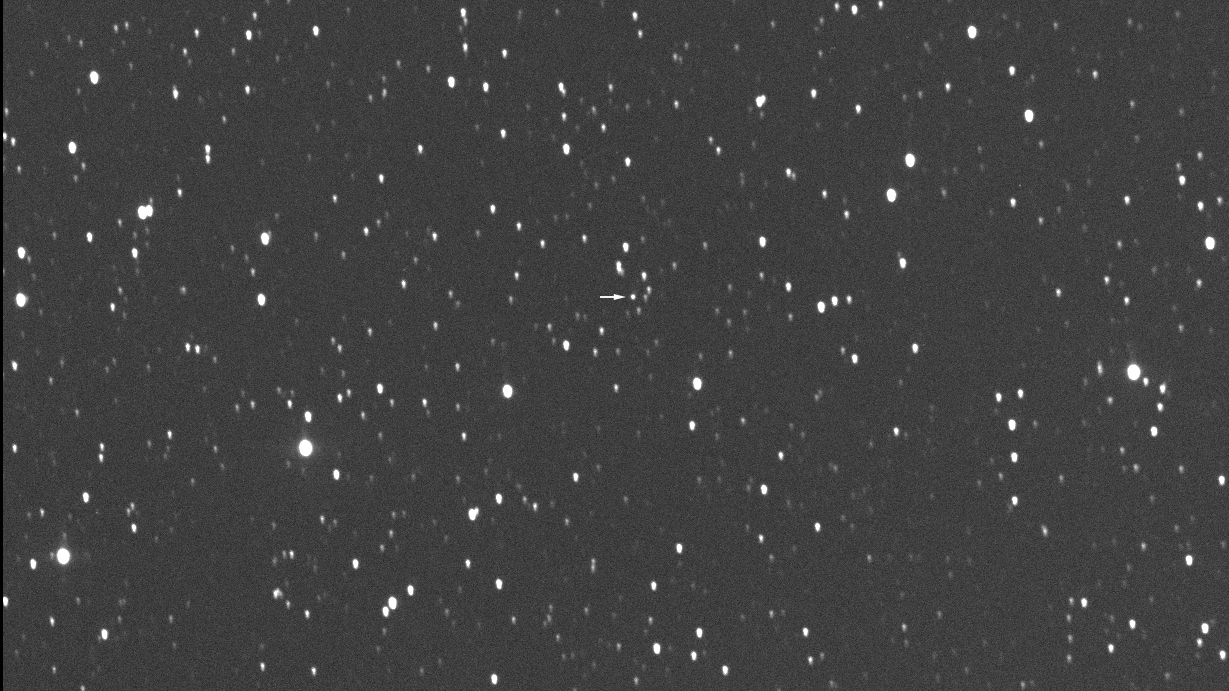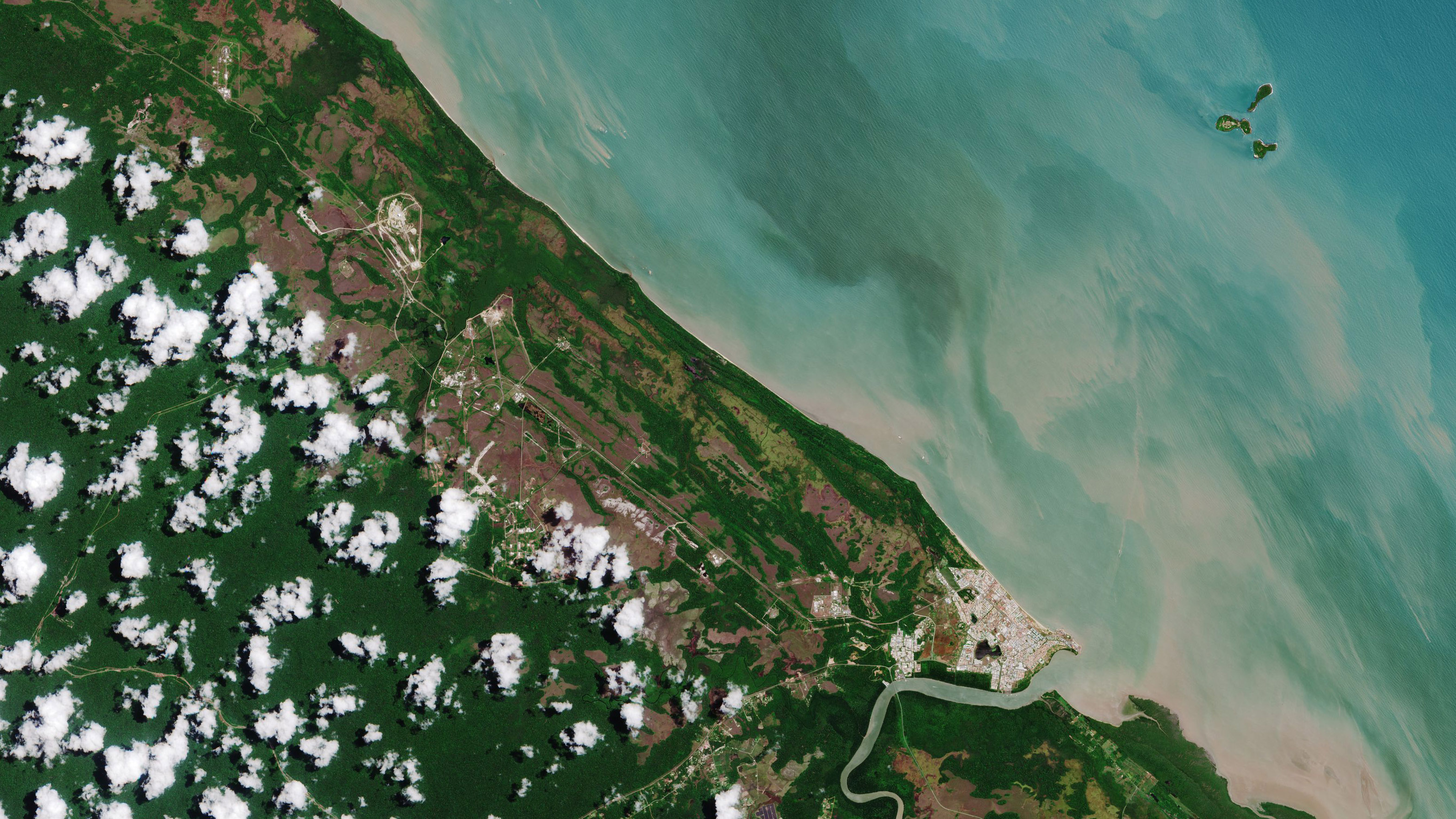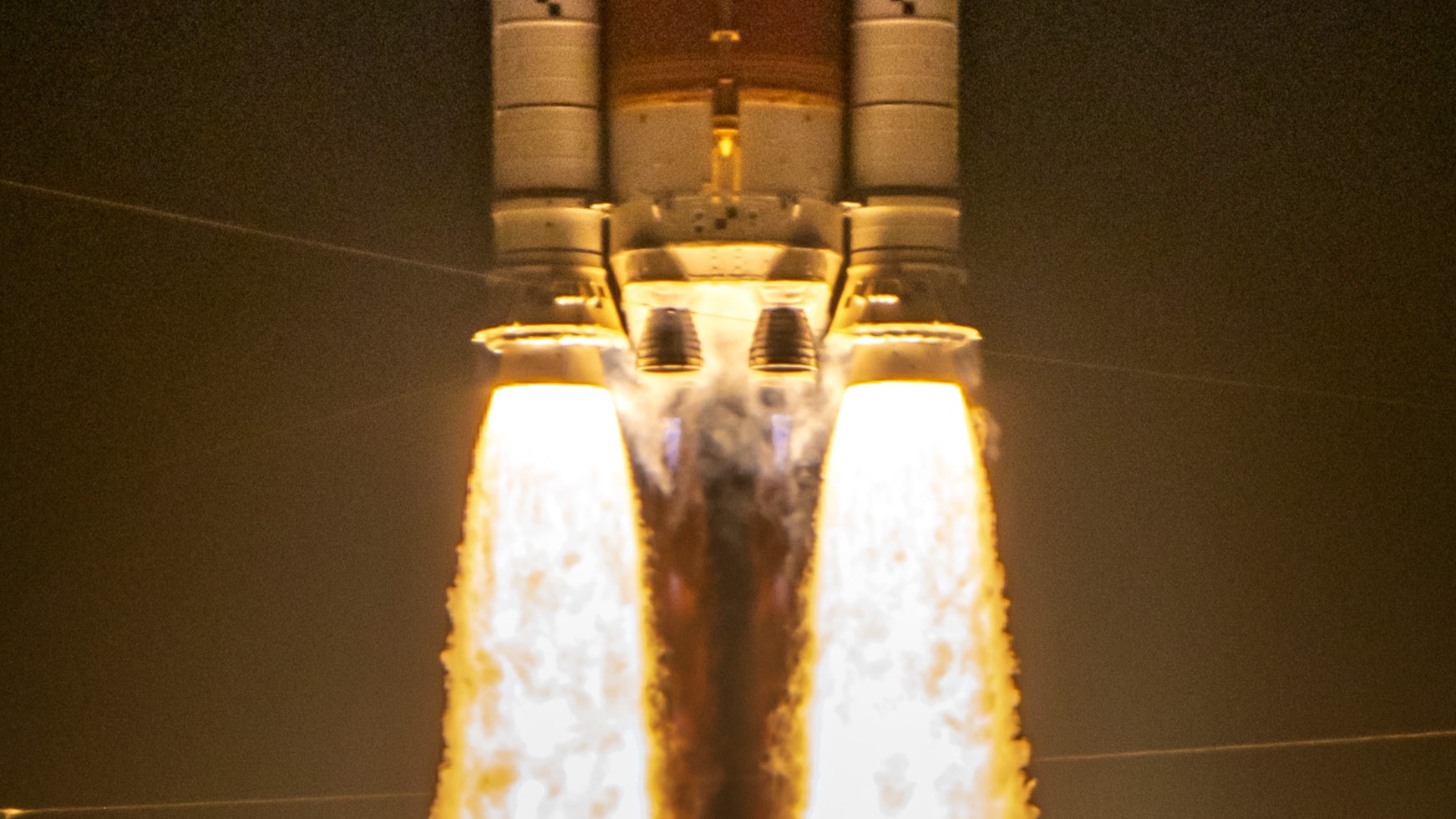December 2021
New Year begins above Antarctica

Friday: December 31, 2021: The International Space Station passed above Antarctica just as the New Year began for the crew aboard the orbital outpost.
NASA astronaut Raja Chari shared the image on his Twitter account today (Dec. 31, which was already January 1 in New Zealand and Australia), saying: "Started off the year with an amazing view of Antarctica while off the South American coast...the same area that Shackleton explored long ago with his crew, #Endurance."
Ernst Henry Shackleton was a British polar explorer who in the early 20th century led three expeditions to Antarctica. His 1915 expedition on the ship Endurance, the namesake of the Dragon Crew capsule that brought Chari and his crew mates to the space station in November 2021, nearly ended in a disaster after it got stuck in ice. Let's hope the crew of the spaceship Endurance continues having a smooth ride in space and lands safely back on Earth in the spring of 2022. – Tereza Pultarova
James Webb Space Telescope speeding away from Earth

Thursday: December 29, 2021: An Italian astronomer captured an image of the James Webb Space Telescope as it cruised towards its destination, at that time about 340,000 miles (550,000 kilometers) away from Earth.
The image was taken by the Elena telescope located in Ceccano, south of the Italian capital Rome, on Wednesday (Dec. 29) at 4.26 pm EST (21:26 GMT). The telescope, part of the Virtual Telescope project, spotted Webb at about 1.5 times the moon-Earth distance. Although it's not visible in this image, the telescope was just extending its deployable tower assembly (DTA), a 48-inch-long (1.2 meters) shaft that connects the telescope's two halves, NASA officials said in a statement.
The DTA creates necessary space between the part of the telescope that houses its enormous mirror and scientific instruments and the spacecraft bus, which houses its electronics and propulsion systems.
The image, taken in a single 120-second exposure, shows the tennis court-sized observatory as a small dot in the middle, marked by an arrow.
Get the Space.com Newsletter
Breaking space news, the latest updates on rocket launches, skywatching events and more!
The James Webb Space Telescope, which successfully launched after three decades of development and many years of delays from the European spaceport in Kourou, French Guiana, on Christmas Day (Dec. 25), is the most complex and most expensive space observatory ever built. The telescope is now heading to the Lagrangian point 2 (L2), a point on the sun-Earth axis behind the planet, where the gravitational forces of the two bodies will allow it to remain in a stable position. The telescope will reach L2, some 930,000 miles (1,5 million km) away from Earth, by the end of January. Due to its size, the telescope had to be folded for launch and is now building itself like an origami during its journey. – Tereza Pultarova
The darkness of Alaskan winter

Wednesday: December 29, 2021: A timelapse video showing the passage of 2.5 late December days in Alaska with the northern parts of the state submerged in continuous darkness.
The timeless, captured by the National Oceanic and Atmospheric Administration's (NOAA) GOES West satellite, shows how little sunlight the northernmost U.S. state receives in winter. Anchorage, on the south coast, gets 5 hours and 33 minutes of daylight this time of the year, Fairbanks, in the central region, only sees 3 hours and 51 minutes, while the northern Utqiaġvik (Barrow) won't see any daylight until January 22, 2022. – Tereza Pultarova
High five for science!

Tuesday, December 28, 2021: NASA Associate Administrator Thomas Zurbuchen and French space agency head Philippe Baptiste celebrate confirmation that the James Webb Space Telescope successfully deployed its solar arrays on Dec. 25. The duo watched the launch from the Jupiter Hall of the European launch site in Kourou, French Guiana, from which the telescope launched aboard an Ariane 5 heavy-lift rocket. The observatory is now conducting a month-long deployment sequence and then must calibrate its instruments; scientists hope that it will begin observations in the summer of 2022. – Meghan Bartels
Bon voyage, James Webb Space Telescope

Monday: December 27, 2021: NASA's James Webb Space Telescope soars off into space after a flawless Christmas Day launch on Dec. 25.
Webb, a $10 billion infrared space telescope, is the largest and most powerful space observatory ever built. The newest of NASA's Great Observatories, it launched atop an Arianespace Ariane 5 rocket from the Guiana Space Center in Kourou, French Guiana.
Related: How the James Webb Space Telescope works in pictures
Live updates: NASA's James Webb Space Telescope mission
This view of Webb is the last humanity will ever see of the observatory. A camera on the upper stage of the Ariane 5 rocket recorded this in a video of Webb's separation from the booster.
The Webb space telescope is headed to a stable gravitational point near Earth called Lagrange 2, or L2, where it will begin its mission to observe the universe. – Tariq Malik
James Webb Space Telescope's last day on Earth

Friday: December 24, 2021: An Ariane 5 rocket that will loft the James Webb Space Telescope to orbit tomorrow (Dec. 25) sits on a launch pad at the European spaceport in Kourou, French Guiana, with its precious payload aboard.
The European Space Agency (ESA), which is providing the launch, confirmed earlier today that the latest weather forecast allows the already heavily delayed launch to go ahead. The anticipated lift-off is expected to take place at 7:20 a.m. EST (1220 GMT). The telescope will then commence its one-month journey to the Lagrangian Point 2, a point on the sun-Earth axis hidden behind the planet, where the gravity of the two bodies will keep it in a stable position. During this journey, the telescope will gradually unfold its sunshield, mirrors and solar arrays in a complex and never before executed deployment procedure. – Tereza Pultarova
Seeing underneath the surface of Jupiter's moons

Thursday: December 23, 2021: A novel radar instrument that will enable scientists to peer 5.6 miles (9 kilometers) below the surface of Jupiter's moons has been tested ahead of the 2023 launch of a new Jupiter exploring mission.
The Radar for Icy Moons Exploration (RIME) instrument will fly on the European Jupiter Icy Moons Explorer mission (Juice) that is expected to reach the largest planet of our solar system in 2031.
In this image, RIME is tested on a 1:18 scale model of the Juice spacecraft inside the European Space Agency's radiofrequency and antenna test chamber at the ESTEC center in the Netherlands.
The goal of the Juice mission is to search for signs of life on Jupiter's icy moons. – Tereza Pultarova
The spacewalker's view of the International Space Station

Wednesday: December 22, 2021: NASA astronaut Thomas Marshburn captured this image of the International Space Station during a space walk in early December.
During the spacewalk, Marshburn and fellow NASA astronaut Kayla Barron replaced a faulty antenna and performed some maintenance around the orbital outpost.
Marshburn shared this image on Twitter on Monday (Dec. 20), saying: "Another view of the @Space_Station from 60 feet up during our spacewalk a couple of weeks ago. I couldn’t bend over in my spacesuit to see this view but luckily captured almost the whole Space Station with a shot in the blind." – Tereza Pultarova
Last glimpse of the James Webb Space Telescope

Tuesday: December 21, 2021: The James Webb Space Telescope is disappearing inside the fairing of the European Ariane 5 rocket that will launch it to space as the observatory finally readies to commence its journey of ground-breaking discoveries after more than a decade of delays.
The fairing will protect the $10 billion telescope during launch and ascent through the atmosphere after it lifts off from Europe's spaceport in Kourou, French Guiana, on Friday (Dec. 24).
The launch, recently delayed because of a faulty data cable, will be observed with apprehension among Christmas festivities by hundreds and thousands of scientists and engineers all over the world who have participated in its 30 years of development and who will work with the precious data that the telescope is expected to deliver.
The biggest, most complex and most expensive space observatory ever built, the James Webb Space Telescope is set to revolutionize many areas of astronomy. Built to detect the first stars and galaxies that formed after the Big Bang, the telescope will also trace the evolving chemical composition of the universe, analyze atmospheres of exoplanets and look into the outer fringes of the solar system in unprecedented detail. – Tereza Pultarova
Japanese billionaire lands after a 12-day space trip

Monday: December 20, 2021: Japanese billionaire Yusaku Maezawa shortly after the landing of a Soyuz capsule that brought him and his assistant back to Earth after 12 days at the International Space Station (ISS).
Maezawa and assistant/videographer Yozo Hirano were the first space tourists visiting the orbital outpost since the 2009 trip of Canadian businessman Guy Laliberté. The two arrived at the ISS accompanied by Russian cosmonaut Alexander Misurkin who also commanded their return trip. The three space travellers landed on Sunday (Dec 19) 10:13 p.m. EST (0313 GMT or 9:13 a.m. local time on Dec. 20) on the steppe of Kazakhstan, southeast of the town of Dzhezkazgan.
Maezawa, 46, is the CEO of Start Today and founder of ZOZO, an online retail clothing business, which he sold to Yahoo! Japan. In 2018, he paid an undisclosed but substantial amount to SpaceX for a circumlunar flight on the company's still-in-development Starship spacecraft. Maezawa's "dearMoon" mission, which will fly him and a crew of artists around the moon, is currently targeted for launch in 2023. – Tereza Pultarova
Europe's spaceport readies for James Webb Space Telescope launch

Friday: December 17, 2021: The European Spaceport in Kourou, French Guiana, where preparations for the launch of the James Webb Space Telescope are in full swing, captured by the European Copernicus Sentinel-2 mission.
The spaceport will send off Webb, the most complex and expensive astronomical observatory ever flown in space, hopefully on Friday, Dec. 24. The launch has recently been delayed because of a faulty data cable that slowed down the final health checks of the spacecraft before its encapsulation into the rocket fairing.
Kourou is located some 40 miles (60 kilometers) from French Guiana's capital Cayenne. The town's position close to the equator is ideal for a spaceport, as the rotation of Earth gives every rocket an extra nudge. – Tereza Pultarova
Find an astronaut

Thursday: December 16, 2021: It is not known what the clutter in this picture is, but these are the legs of NASA astronaut Raja Chari sticking out from the middle of it all.
Chari, who arrived at the orbital outpost on Nov. 11 as part of SpaceX Crew-3, posted the picture on his Twitter account with a few others on Wednesday (Dec. 15).
"Daily life on @Space_Station always changes for @NASA_Astronauts — got to do plant gene science, dive into a giant space closet, and try to keep my heart & legs healthy all in one day," he said.
We assume this picture is that of the giant space closet. –Tereza Pultarova
James Webb Space Telescope mounted on its rocket

Wednesday: December 15, 2021: The James Webb Space Telescope has been placed on top of the Ariane 5 rocket ahead of its launch next week from the European Spaceport in Kourou, French Guiana.
While the telescope is being attached to the launch vehicle adaptor, the rest of the rocket is hidden under the engineering platform. The telescope and the adaptor are shrouded by a curtain to avoid contamination.
In the next days, engineers will seal the telescope inside a protective rocket fairing, which had to be specially adapted to accommodate the giant telescope. – Tereza Pultarova
The peaking Geminid meteor shower

Tuesday: December 14, 2021: Chinese photographer Xue Bing captured this long-exposure image of meteor streaks over cliffs in the Bazhou region in China during the peak of the Geminid meteor shower on Dec. 14.
The Geminid meteor shower, caused by debris from the near-Earth asteroid 3200 Phaethon, is one of the most intense annual meteor showers observable from Earth. In years when the shower coincides with the new moon, skywatchers in dark locations can spot up to 150 meteors per hour. The 2021 peak on Dec. 13, however, took place just a few days before the full moon. The bright moonlight therefore outshined many of the fainter meteorites.
Still, the image obtained by Xue Bing is spectacular, showing dozens of trails of various brightness levels. -- Tereza Pultarova
Satellites capture trail of devastation left by Kentucky twister

Monday: December 13, 2021: The trail of devastation left by a powerful tornado that ripped through the town of Mayfield in Kentucky over the weekend has been captured by Europe's Sentinel 2 Earth-observing satellite.
The two images in the mosaic above show Mayfield on Dec. 11, just after the disaster struck.
Mayfield wasn't the only town hit by the forceful natural phenomenon over the past weekend. Weather experts had estimated that more than 40 tornadoes stormed through nine U.S. states in the past days.
Authorities are still assessing the damage. In Kentucky alone, the tornadoes are believed to have killed at least 50 people. -- Tereza Pultarova
James Webb Space Telescope moved for rocket integration

Friday: December 10, 2021: The James Webb Space Telescope has been transferred to the final assembly building at Europe's spaceport in Kourou, French Guiana, where it will be mounted on top of the Ariane 5 rocket ahead of its Dec. 22 launch.
The precious telescope that cost $10 billion and took more than 30 years to build, was placed into a protective 23-ton container during its final short trip before the beginning of its space journey.
The 6.2 metric ton telescope will now be lifted onto an elevated platform for encapsulation into the rocket fairing, which had to be adapted to accommodate the giant space explorer.
Webb, the largest and most powerful space telescope ever built, will peer into the most distant corners of the universe, promising to detect the earliest stars and galaxies that formed after the Big Bang. The telescope is expected to generate ground-breaking discoveries that will revolutionize our understanding of the universe's early years and its evolution. It will also provide an unprecedented window into star formation and chemical composition of planets around distant stars. -- Tereza Pultarova
Space station crew poses for family portrait with Japanese space tourists

Thursday: December 9, 2021: Astronauts and cosmonauts on the International Space Station welcomed Japanese space tourists, billionaire Yusaku Maezawa and his assistant Yozo Hirano, who arrived accompanied by cosmonaut Alexander Misurkin.
The latest arrival expanded the current crew of the space station to ten members. The crew posed for this family portrait on Wednesday (Dec. 8) shortly after the arrival of the Soyuz capsule that brought Maezawa, Hirano and Misurkin to the station.
The two tourists plan to spend their twelve days on the orbital outpost filming videos and going through a "bucket list" of things to do in space.
They will return to Earth, accompanied by Misurkin, on Dec. 20. -- Tereza Pultarova
Japanese billionaire Yusaku Maezawa heads for space station

Wednesday: December 8, 2021: Japanese billionaire Yusaku Maezawa tucked inside Russia's Soyuz spacecraft heading for a nearly two-week trip at the International Space Station.
Maezawa, who launched to the orbital outpost from Russia's Baikonur Cosmodrome on Wednesday 2:38 a.m. EST (0738 GMT or 12:38 p.m. local time), is the first space tourist to visit the orbital outpost since 2009.
He is accompanied by his assistant Yozo Hirano, who will film the entire experience. With them inside the Soyuz capsule was the flight's commander Russian cosmonaut Alexander Misurkin.
Maezawa, a life-long space enthusiast, is also expected to fly to the moon with SpaceX's dearMoon mission, currently scheduled for 2023. -- Tereza Pultarova
'Space suits' protect James Webb technicians from toxic fuels

Tuesday: December 7, 2021: Engineers fuelling the James Webb Space Telescope (JWST) wear protective 'space suits' to avoid poisoning by toxic chemicals that will help keep the precious spacecraft stable in space.
The engineers took ten days to fill the telescope's propellant tanks with 79.5 liters of dinitrogen tetroxide oxidiser and 159 liters of hydrazine. The operation was completed on Dec. 3, more than two weeks ahead of the mission's Dec. 22 launch.
As both, hydrazine and dinitrogen tetroxide, are extremely toxic, only a few trained specialists wearing protective suits resembling spacewalking attire were allowed into the fuelling hall.
The engineers will next place the 6,2 metric ton JWST inside a protective rocket fairing that will be mounted on top of the Ariane 5 launch vehicle prior to the transfer of the combo for final assembly. -- Tereza Pultarova
Satellites observe as climate change speeds up Antarctic current

Monday: December 6, 2021: Satellite data reveal the climate change-related speeding up of the Antarctic Circumpolar Current.
The current, which circles the icy continent from west to east, is the largest ocean current on the planet and the dominant feature influencing the Southern Ocean. In recent years, scientists have noticed the current is speeding up due to the progressing climate change.
Some experts worry the acceleration of the powerful current might further speed up climate change as it could decrease the capacity of the Southern Ocean to absorb carbon dioxide, the dominant greenhouse gas, from the atmosphere.
This image, based on data from the European Copernicus Earth-observation program, shows the ocean flow around the south-pole ice cap on Dec.3. -- Tereza Pultarova
Mars rover shows off its sand escape skills

Friday: December 3, 2021: The ExoMars rover tested its ability to escape from sand in a recent test at an Italian 'training center' where it practices for its upcoming mission.
The test model of the joint European/Russian rover, which will set out for its trip to the red planet next year, used its wheel-walking mode that was designed by engineers specifically to help the rover get unstuck in sandy terrain.
Several Martian rovers in the past struggled to free themselves from sand dunes, with their wheels digging them deeper just like a car stuck in mud or snow.
Teams developing the ExoMars Rosalind Franklin rover, which will search for traces of life underneath the surface of Mars, have therefore developed the wheel-walking locomotion mode, which uses individual wheels like legs. In the test, it took Rosalind Franklin two minutes to cross the 6.6 feet (2 meters) wide sand trap. -- Tereza Pultarova
Astronauts suiting up for spacewalk

Thursday: December 2, 2021: NASA astronauts Kayla Barron and Thomas Marshburn are suiting up for a Thursday (Dec. 2) spacewalk in an image captured by their colleague Matthias Maurer.
During the more than six hour spacewalk, which was postponed because of space debris risk, the two astronauts replaced a faulty antenna on the space station's truss. For Barron, who is on her first space mission, this was also the first spacewalk. Mashburn, on the other hand, is a seasoned astronaut and an experienced spacewalker who has worked outside the space station multiple times since his first spaceflight in 2009.
The two spacewalkers arrived at the orbital outpost with SpaceX's Crew-3 mission on Nov. 11 together with Raja Chari, also of NASA, and European astronaut Matthias Maurer. It was Maurer who shared the image of the spacewalk preparations on his Twitter account. -- Tereza Pultarova
Pieces of an asteroid on a trans-Pacific trip

Wednesday: December 1, 2021: Precious extra-terrestrial samples delivered to Earth by a Japanese space probe last year crossed the Pacific Ocean, travelling incognito locked in unassuming black containers.
Scientists from the Japan Aerospace Exploration Agency (JAXA) accompanied pieces of asteroid Ryugu on their journey from Japan to NASA's Johnson Space Center in Houston, Texas.
Analyses of the asteroid bits will continue in laboratories in Japan and around the world, JAXA said in a statement.
Ryugu is a 0.6 mile-wide (1 kilometer) asteroid that scientists consider a potential threat to Earth. In 2018, Japanese spacecraft Hayabusa2 visited the asteroid, spending a year and a half studying its surface and structure. During its mission, the spacecraft collected three samples of material from the surface and near subsurface of the asteroid, which successfully arrived at Earth in December 2020. -- Tereza Pultarova
Can't find the date you're looking for? It may have been a weekend or holiday, when we don't normally update our Image of the Day.
Image of the Day Archives
Check out our Image of the Day Archives for more awesome photos.
Image of the Day 2024 Archive

Image of the Day 2023 Archive

Image of the Day 2022 Archive

Image of the Day 2021 Archive

Image of the Day 2020 Archive

Image of the Day 2019 Archive

Join our Space Forums to keep talking space on the latest missions, night sky and more! And if you have a news tip, correction or comment, let us know at: community@space.com.

Space.com is the premier source of space exploration, innovation and astronomy news, chronicling (and celebrating) humanity's ongoing expansion across the final frontier. Originally founded in 1999, Space.com is, and always has been, the passion of writers and editors who are space fans and also trained journalists. Our current news team consists of Editor-in-Chief Tariq Malik; Editor Hanneke Weitering, Senior Space Writer Mike Wall; Senior Writer Meghan Bartels; Senior Writer Chelsea Gohd, Senior Writer Tereza Pultarova and Staff Writer Alexander Cox, focusing on e-commerce. Senior Producer Steve Spaleta oversees our space videos, with Diana Whitcroft as our Social Media Editor.









